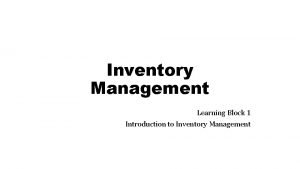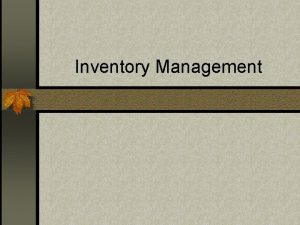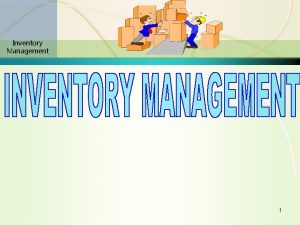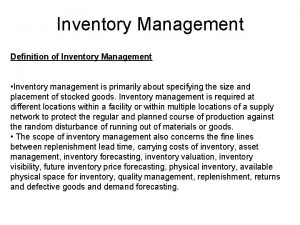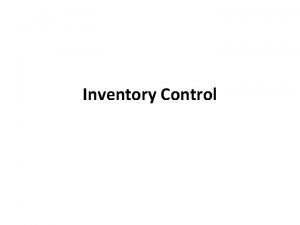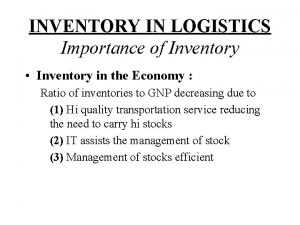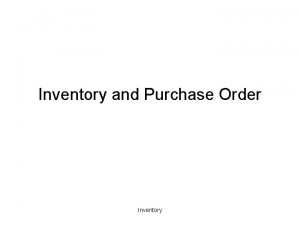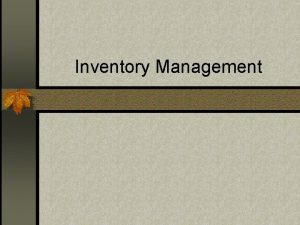Inventory Management Introduction n Inventory management is the















- Slides: 15

Inventory Management

Introduction n Inventory management is the system devised and adopted for controlling investment in inventory n The aim of inventory management is to attain a healthy balance between the cost of not having. n Bad management of inventory may lead to overstocking or stock outs.

Types of Inventory Direct inventories Raw Materials Work in progress Finished Goods Indirect Inventories Transit or movement inventories Buffer inventories or Safety stocks Lot size inventory Seasonal inventory Fluctuation inventory

Objective of Inventory n Hedge against inflation n Protection against fluctuation in demand n Protection against fluctuation in supply n To avoid stock outs and shortage n Quantity discount n Optimum use of men, machine and materials n Helps prevent wastage

Steps in Inventory Control n Formulation of Policy n Location of warehouses n Determination of EOQ n Determination of safety stocks n Determination of lead time

Types of inventory n Deterministic model – these are simple models in which it is assumed that The demand or consumption rate is known with certainty n Constant lead time is involved in procurement n n Probabilistic model – here the demand follows a known probability distribution, while the lead time may either be constant or variable with a known probabilistic distribution n Static model – static model relate to a single decisions process in which only a single purchase order can be placed to meet the demands. Eg. Bread and eggs at a grocery n Dynamic – the decision on one procurement process will affect the subsequent procurement. A printer and its consumbables

Types on Inventory Models n EOQ n Assumptions under this model n The demand is known and is constant and occurs uniformly over time n The replenishment is in a single delivery n The lead time can be estimated deterministically n The cost on the units is the same irrespective of the lot size n Unit cost of ordering and storing can be calculated n The inventory system pertains to a single inventory

Inventory Cost n Direct Material Cost n Ordering Cost n Holding Cost n Shortage or Back order cost

Inventory Control n All inventory items need not be controlled with n n n equal importance Some items are very important and require a tight and intensive control The items are classified on different bases ABC analysis: Materials are divided into three categories – A, B, C “A” Category items are high value items and require tight control “B” Category items are managed by stocks management system and do not require regular control

n “C” category items are usually common items n n n and requires minimum management 10% of the items. i. e “A” category items contribute to 60% of the cost 60% of the items. i. e “B” category items contribute to 10% of the cost Policies for high items Order the more frequently to avoid lock up of capital The items should be delivered promptly from the supplier

n Monthly report must be set to ensure proper n n n usage of the material Policies for “B” category items They should be ordered less frequent then “A” category item Recorder level, safety stock and such other norms have to be applied to these stock items Policies for “C” category items Liberal quantities are to be ordered which may last for 6 months or more as frequent purchase are time consuming

n Annual or six monthly order reduce paper work and the company can avail bulk discount n Items should be grouped according to requirements like electrical requirements, plumbing requirements , etc to help in easy storage

VED Classifications n V – Vital n E – Essential n D –Desirable n Vital items are desirable to smooth production operations n Essential items are those whose stock outs adversely affect the efficiency of the production system n Desirable items are those which do not hamper the process of production

Other methods n HML classifications H – High Value Items n M – Medium Value Items n L – Low Value items n n XYZ classification n Base on the inventory valuation of the items as per the closing stock. High investment items are categorised as “X” items and low investment items are categorized as “Z” items. Helps the company in planning for storage and maintenance n FSND – Fast moving, normal, slow moving and dead items

n SOS – Seasonal and non-seasonal items n GOLF – Government, Open Market, Local supplies and foreign market supplies n SDE – Scare, Difficult to obtain and easy to obtain
 Introduction to inventory management
Introduction to inventory management Storage and inventory control examples
Storage and inventory control examples Inventory management objectives
Inventory management objectives Hát kết hợp bộ gõ cơ thể
Hát kết hợp bộ gõ cơ thể Lp html
Lp html Bổ thể
Bổ thể Tỉ lệ cơ thể trẻ em
Tỉ lệ cơ thể trẻ em Chó sói
Chó sói Glasgow thang điểm
Glasgow thang điểm Hát lên người ơi alleluia
Hát lên người ơi alleluia Kể tên các môn thể thao
Kể tên các môn thể thao Thế nào là hệ số cao nhất
Thế nào là hệ số cao nhất Các châu lục và đại dương trên thế giới
Các châu lục và đại dương trên thế giới Công thức tính độ biến thiên đông lượng
Công thức tính độ biến thiên đông lượng Trời xanh đây là của chúng ta thể thơ
Trời xanh đây là của chúng ta thể thơ Cách giải mật thư tọa độ
Cách giải mật thư tọa độ
